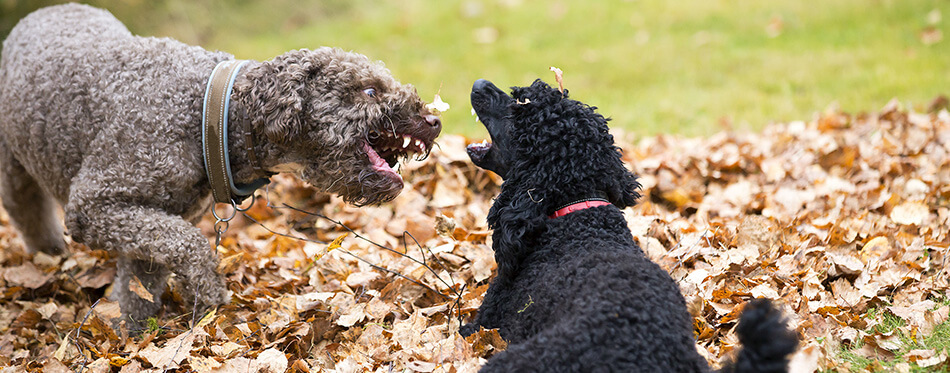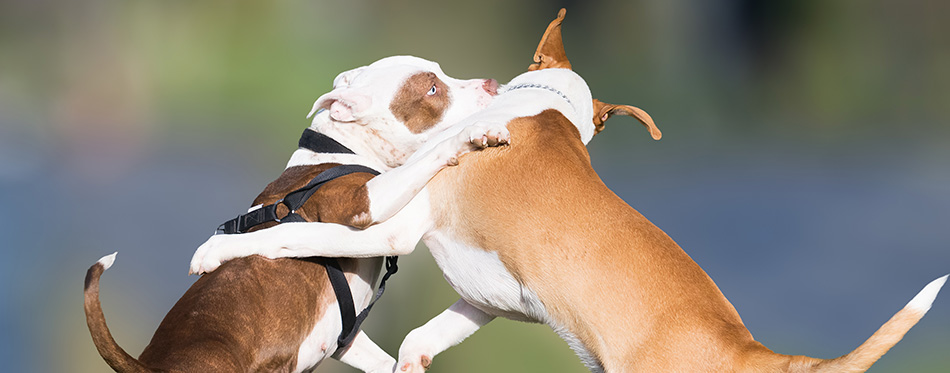Dog fights are very frightening occurrences that can lead to a lot of harm and damage between canines and humans alike. In so many cases, these injuries can be fatal. Whether it’s your dog, another, or both that instigated the fight, it’s our collective responsibility as pet owners to learn how to minimize the amount of damage inflicted.
That’s why we’ve carried out our research and put together a list of questions that need answering regarding dog fights. Read through this guide in depth; possessing prior knowledge of how to react in such dangerous and scary situations will allow you to make a much greater impact at the time.
Why Do Dogs Fight?
There are a multitude of reasons as to why dogs fight. Indeed, the need to fight is ingrained in their natural survivalist instincts as it is in humans. We believe it’s important to emphasize that no matter if your dog is friendly and loving, every canine is capable of viciously fighting if set off by certain situations.
Redirected aggression: The best way to understand redirected aggression is when a dog reacts negatively to another stimulus but cannot reach or take out its energy on it. For example, when your dog notices a cat out the window and sends themselves into a frenzy, they may then take out their frustration on the stimulus closest to them such as another dog in your household.
Territorial: Dogs are territorial creatures by nature. In fact, many dog breeds have been bred over time to guard and watch over land.
Protection: The anxiety and fear that dogs must protect who they consider to be the members of their pack contributes massively towards how they interact towards external stimulus.
Overstimulation: A sensory overload can often be responsible for dogs acting aggressively. If what presents itself as a friendly play between friends drags on for too long, one small move can result in playtime turning into a fight.
A combination of slight triggers: Sometimes, a combination of small triggers can result in dog fighting; that is, anything around their environment that cause them to react. Fast-moving cats, how another dog smells, and dogs barking nearby may provoke a negative reaction from agitated dogs.

How to Prevent a Dog Fight
In order to best prevent dog fights in the home and in the dog park, there are certain steps you can put into practice and signs to pick up on.
- At home
Buy separate crates for each dog: Remember our discussion centering around overstimulation above? If dogs share crates, they may start playing for long periods of time. When rigorous play becomes too intense, puppies need space to cool off when the intensity of the play builds up. They have no such space in a small cage, therefore increasing the risk of fighting.
Calm greetings should be encouraged: It’s a lovely feeling when you arrive home from work to find two dogs or more running to greet you. Yet although it’s rewarding to bask in their attention, experts recommend that you don’t give your dogs any attention until they’ve calmed down. Think of your dogs as a pack – if one was to get more attention, the others would get jealous. This technique has been proven to reduce the likelihood of a dog fight breaking out amongst co-habitants substantially.
- In dog parks
Learn to notice aggressive behavioral cues: The vast amount of sensory stimuli in any dog park means it’s more intelligent to focus on the aggressive behavioral cues your pet presents. A dog’s body language is a critical way of towards understanding their needs and an important skill to develop as a dog owner.
Whale eye: A very specific manifestation of a dog’s stress through body language, whale eye is when a dog’s eyes widen to expose the white part of their eyes referred to as the sclera.
If you’re unsure whether your dog’s eyes are showing due to their excitement or due to their anxiety, it’s important to couple whale eye with other body language cues, listed below
- A tense body
- Indirect eye contact or direct stating
- Hiding
- Ears pulled back or to the side
- Raised hackles
If your pup exhibits several of these behaviors when around other dogs, calmly assess the situation and redirect your dog away from the situation. Reward them for coming to your side if called with plenty of dog treats, showing them that this was the right thing to do in this situation.
Work on obedience training regularly: Although obedience training should be most intense when your dog is a puppy, it shouldn’t just end there. Continue to practice positive reinforcement training so you can be confident that whatever situation arises, your dog will return to your side.
How to Stop a Dog Fight
However much you may try to prevent two dogs from fighting each other based on warning signs, the worst happens anyway. In this situation, there’s no time to dwell on what you could’ve done differently – now is the time to act.
- Find an object to fling between two dogs fighting
Never step between fighting dogs. Putting yourself in such grave danger won’t stop dogs from being aggressive. Rather, as a result of confusion, the dogs will most likely mistake you for another target and bite. Consider that if your dog becomes injured due to a dog fight, they’ll need you to be there to look after them.
However, what you should place between fighting dogs is any inanimate object lying around. In fast-paced scenarios, two fighting dogs will become spooked by a flying object in their peripheral that they’ll lose concentration on the fight in progress, allowing you enough time to separate the dogs.
- Doze the fighting dogs down with water
Another solution that will distract dogs is by flinging a bucket of water over them. This unpleasant shock to their systems will again distract them from the anxiety they feel, thereby decreasing their risk of injury.
- Make lots of noise
Finally, loud noises may also help encourage dogs to turn around and away from fighting. If you’re outdoors when a dog fight breaks out, turn to your nearest garbage can lid and start smacking it repeatedly. Prevention is key to eliminate fighting, so why not invest in an air horn and bring it walking in case you need to use it? Seriously, any loud noise you can make, object you can through, or water you can chuck will make all the difference and are among the best ways to break up the fight.
Cover their head with a blanket: Dogs will stop fighting if they’re unable to see what’s going on around them. Grabbing a cover and throwing it over from behind will momentarily distract one dog, allowing you time to pull the dogs away from one another. What’s more, covers can reduce the impact of dog bites, reducing the risk of injury.
Things to Do When You Can’t Break Up a Fight
If you’ve tried all distraction techniques available but to no avail, it’s time to become physically involved yourself without stepping into the middle of a dog and dramatically increasing your risk of collateral damage. The wheelbarrow method is regarded by experts as the best way to break up a fight if dogs keep fighting. As often owners find themselves alone when dogs fight break out, we’d like to address how to stop dogs from fighting by using the wheelbarrow method individually and with multiple people.
- Individually
If you’re alone with dogs fighting, you’ve got to be more creative and use a leash. Sliding the end of the leash into the looped end to create a sling, slip it under one dog’s belly. Ideally, this sling should be placed nearer their groin rather than their chest. Like an adaptive wheelbarrow movement, you should pull your sling up to take the dog off their hind legs.
If the other dog continues to attack, however, move swiftly around to their rear and use the wheelbarrow method to lift their back legs with your hands. As reiterated previously, resist your urge to jump into the middle in order to keep the dogs apart.
- Together
Together, how to separate fighting dogs by using the wheelbarrow is much easier. Each person should grab a dog’s back feet and, at the same time, pull them away another. This movement must be simultaneous as otherwise, one dog won’t be able to defend themselves whereas another will be able to attack with no resistance.

What to Do After a Dogfight
If your dog or another has receive a serious injury resulting from the fight, stay calm and take them straight to a veterinarian immediately. It’s completely understandable that owners’ emotions run high – especially if the other owner’s dog was the aggressor during the dog fight – but don’t spend any precious energy casting blame. Owners should remain calm work together to ensure dogs receive medical treatment as soon as possible before anything else like exchanging contact information takes place.
If it seemed as though your dog didn’t get hurt from the fight itself, underlying injuries may start to present themselves in a few days time. Therefore, keep a close eye on your pet for several days after the incident to see whether any injuries become apparent.
Stay Calm and Collected
Above all else, staying calm and collected when your dog or another displays signs of aggression or engages in a heated fight is the best way to avoid injuries. Although it’s certainly tempting to let emotions overwhelm you – understandably, given that your pup is fighting aggressively – the best way to deal with a fight is by taking a deep breath and implementing the techniques discussed above.

